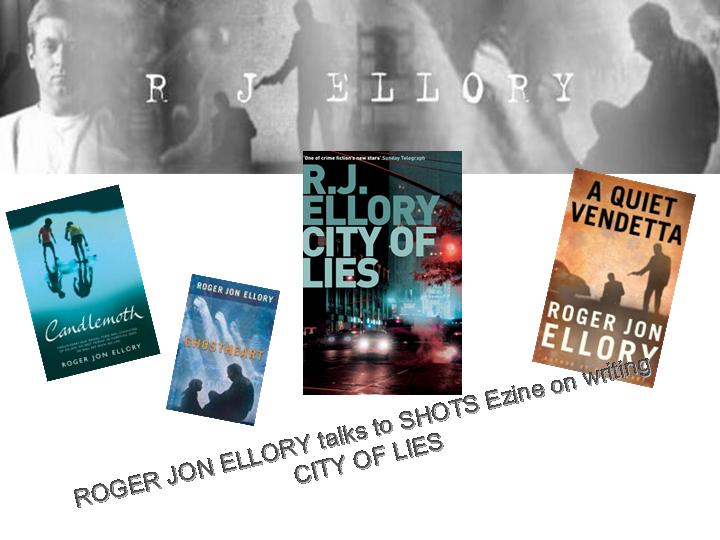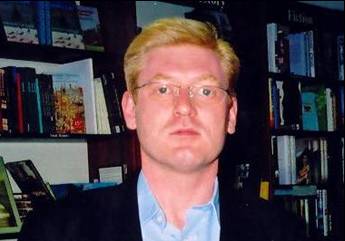

|
A writer I have followed since his debut in 2003 is the highly literate Roger Jon Ellory. His writing style is hugely descriptive, layered by character and intertwined by a fast-moving and sometimes brutal plot. But at the heart of his work is his ability to tell a great story, because that’s what he does: writes a story that takes you away from the day-to-day world and submerges you into the terrifying world of gangsters, crooks and damaged people. I have heard a great deal about his upcoming opus ‘City of Lies’ so I was delighted when Roger agreed to talk to Shots eZine about this new book.
If you’ve not added Roger Jon Ellory to your bookcase, you are missing out on one of our greatest storytellers – Ali Karim
 Following
the publication of ‘Candlemoth’ in 2003 and ‘Ghostheart’ in 2004 I
completed a novel entitled ‘Burying Goliath’. I submitted this manuscript to my
editor in March of 2004 and then met with him to discuss some changes we
considered necessary. Following our discussion he asked me what I was working
on for book number four. I happened to have about 40,000 words with me on a
disc – a ‘vast Mafia epic spanning seventy years and ten different cities’. My
editor asked if he could read it, and he took a copy. I returned home to
Birmingham, and two days later he called me to say that he wanted to publish the
new fourth novel to follow ‘Ghostheart’, instead of ‘Burying Goliath’.
He asked if I could complete the book within eight weeks. The resultant script
was ‘A Quiet Vendetta’, released in August 2005.
Following
the publication of ‘Candlemoth’ in 2003 and ‘Ghostheart’ in 2004 I
completed a novel entitled ‘Burying Goliath’. I submitted this manuscript to my
editor in March of 2004 and then met with him to discuss some changes we
considered necessary. Following our discussion he asked me what I was working
on for book number four. I happened to have about 40,000 words with me on a
disc – a ‘vast Mafia epic spanning seventy years and ten different cities’. My
editor asked if he could read it, and he took a copy. I returned home to
Birmingham, and two days later he called me to say that he wanted to publish the
new fourth novel to follow ‘Ghostheart’, instead of ‘Burying Goliath’.
He asked if I could complete the book within eight weeks. The resultant script
was ‘A Quiet Vendetta’, released in August 2005.
‘Burying Goliath’ was quietly and ceremoniously buried, but there was something about the central character – a once-published novelist and newspaper journalist called John Harper – who I missed. And so when it came to working on another novel I resurrected John, and following the laborious task of transferring about 10,000 words from first person to third person, I used that material for the beginning of a script with the working title ’66 Carmine’.
66 Carmine was a New York address, a house where John was raised by his Aunt Evelyn, having lost his mother and father very early in life. At nineteen he left New York and headed for Florida, wrote one novel, and then became a newspaper journalist for the Miami Herald.
After seventeen years away from New York, John Harper learns that the father he believed dead for more than thirty years is alive, though lying in a deep coma in a Manhattan hospital. Returning home brings with it memories of childhood, many of them painful, and a shocking truth that Harper could never have prepared himself for.
Confronted with the truth of his father’s existence, Harper finds himself seduced by a lifestyle that he seems to have inherited – an underworld life of power, treachery and menace.
Desperately trying to uncover the facts of his own past, he is faced with one lie after another, and with each new discovery he is drawn further into a conspiracy that will result in one of the most audacious criminal enterprises in New York’s history.
Twisted like a Gordian knot, the story weaves back and forth between truth and fiction towards its explosive conclusion.
The finished work, entitled ‘City of Lies’, is a novel about identity, about the truth of one man’s life, and how the discovery of facts about the past have the power to influence the present.
After ‘Candlemoth’, ‘Ghostheart’ and ‘A Quiet Vendetta’, all of them structured in a double-narrative style (where two stories run simultaneously and ultimately become the same thing), I wanted to write something that was a purely ‘linear’ thriller. Spanning a series of days (in this case the twelve days leading up to Christmas Eve), I wanted ‘City of Lies’ to read very rapidly. Almost cinematic in its nature, I began with the idea that a book could be written in such a way as to present consecutive images that overlapped one another, and as each new sequence was detailed something further was gleaned about the overall plot. In my mind’s eye I imagined being able to take a pencil and put a line through all the descriptive passages and leave nothing but locations and dialogue, in essence a film script. The dialogue was the driving force behind the atmosphere of the book, and here I invested the greatest amount of care. The people Harper becomes involved with upon his return to New York are effectively ‘old school’ gangsters, some of them in their fifties and sixties, and though they are dated I still wanted their conversations and expressions to reflect the awareness that the New York of the 21st Century was not the same as New York in the seventies and eighties. These people have become a dying breed, out-run and outflanked by the Hispanic gangs, the Eastern Europeans, the crack dealers and gun sellers. Harper himself is caught in the midst of an incipient war over conflicting territories, and though he is in no sense a gangster he is nevertheless both seduced and manoeuvred into a position where he has an active part to play in the outcome of the war.
Where previous novels have perhaps concentrated on the creation of an evocative atmosphere and the use of prose as a character in itself to give substance and body to the material, ‘City of Lies’ has stepped away from that. In essence it is a much more direct and succinct work, concentrating far more on the situations the characters find themselves in, and less on the world around them.
As an author you are primarily a storyteller, and though the prose and language is of vital importance, and in essence is one’s ‘style’, there comes a point where the prose itself can sometimes swamp and obscure the story itself. Though my first love is for the language itself, I felt that after ‘A Quiet Vendetta’ I wanted to write something that possessed far more pace and drive. If ‘Vendetta’ was a long and all-consuming descent into the world of organized crime, ‘City of Lies’ is more ‘Orpheus into the underworld’, a journey of one man into a world that defies his beliefs, his morals and his vision of himself. Harper is changed by his experiences in more ways that he could ever have imagined, and all within a span of less than two weeks.
Writing ‘City of Lies’ was a tremendous experience, and though it did not take long I feel that it is a significant step forward and a considerable expansion of my repertoire as a novelist. It is a book of which I am proud, and feel very strongly that it will appeal to ‘crime thriller readers’ in a way that possibly the first three books have not. I believe that in reading it there will be a number of readers who thoroughly enjoy the story itself, but more than that, a significant percentage of readers who appreciate the fact that a great story can be written in a literary style that is uncommon in this genre.
A critic once reviewed one of my books, and her review concluded with the view that the books I have written were neither ‘crime’ nor ‘thrillers’ nor ‘adventure stories’, but were more like human dramas where the characters continually found themselves challenged by viewpoints and realities that were both emotionally difficult and mentally untenable. They find themselves in places where they never intended to go, and do not wish to remain. Their purpose becomes to recover their own lives and identities, but failing that they recover what they can but never view life from the same perspective.
My goal as a novelist has been very simple. Someone once told me that there were two types of novel: those that you just could not put down, where the narrative drive carried you through to the end ‘because you just had to find out what happened. Secondly, there were those novels that were read and appreciated simply because of the style of writing and the nature of the prose. I appreciate both types of books very much, and thus I have always striven towards creating works that are a combination of the two. With ‘City of Lies’ I hope I have achieved this to a marked degree, and hope also that there will be a sufficiently wide readership garnered to allow me the pleasure and ability to continue to write, for this is my passion and my purpose, above all else.
CITY OF LIES is published in Hardback by Orion, September 6th 2006, £9.99
Photographs © 2003 Ali Karim
More information about R J Ellory :- www.rogerjonellory.com
Previous interviews and articles at Shots :-
http://archive.shotsmag.co.uk/shots21/intvus_21/rellory.html
http://archive.shotsmag.co.uk/features2005/rj_ellory/quietvendetta.html
http://archive.shotsmag.co.uk/reviews2005/reviews0805/aquietvendetta.html
http://archive.shotsmag.co.uk/ghostheart_ellroy_review.htm#ghosheart
http://archive.shotsmag.co.uk/CRIME%20REPORTS%20REVIEWS/candlemoth_review.htm#CANDLEMOTH

| Webmaster: Tony 'Grog' Roberts [Contact] |